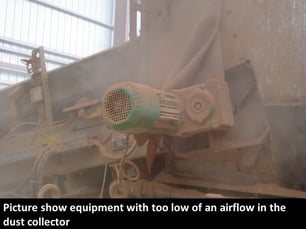The airflow in dust collection systems is crucial to the proper operation of the system. The dust collection system consists of the hood/pickup points, ductwork, dust collector(s) and exhaust fan. The hood/pickup points are designed to capture the dust. This design requires a range of airflows to properly work. If too little airflow is going through the hood, dust will escape from the hood. If too much air is going through the hood, the system can capture material it isn’t supposed to (example picking up product from the conveyor belt, not just dust lingering over the belt in the air).
The Important of Ductwork
 Ductwork is like a highway for the dust in the dust collection system. It allows the airflow to be directed to the dust collector from the pickup points/hoods. The ductwork should be sized so that the airflow velocity is fast enough to keep the dust in suspension, but taking into account that the faster the airflow the higher the pressure drop is through the ductwork. The minimum velocity required to keep the dust in suspension is dependent on the dust. It can vary, but usually 4500 FPM is a safe velocity. Elbows can also increase the pressure drop of ductwork so try to minimize the elbows when designing the ductwork. Make sure you know the pressure drop in your ductwork so you can have enough static pressure in your fan to keep the design airflow.
Ductwork is like a highway for the dust in the dust collection system. It allows the airflow to be directed to the dust collector from the pickup points/hoods. The ductwork should be sized so that the airflow velocity is fast enough to keep the dust in suspension, but taking into account that the faster the airflow the higher the pressure drop is through the ductwork. The minimum velocity required to keep the dust in suspension is dependent on the dust. It can vary, but usually 4500 FPM is a safe velocity. Elbows can also increase the pressure drop of ductwork so try to minimize the elbows when designing the ductwork. Make sure you know the pressure drop in your ductwork so you can have enough static pressure in your fan to keep the design airflow.
Pressure Drop in Dust Collectors
Dust collectors have a pressure drop associated with them. Usually the higher the pressure drop the greater your removal efficiency will be, however different technologies will have different pressure drop and removal efficiencies. For example 10”WC pressure drop on a cyclone will have a lower removal efficiency than 10”WC on a filter. Be sure you have enough static pressure to operate your dust collector throughout the normal life of it. A fabric filter will build up dust on it, thereby increasing its pressure drop over time. Be sure to have enough static pressure to handle the required airflow at the point the filters are dirtiest, or else your airflow will suffer.
Exhaust Fan vs. Airflow
The exhaust fan should be designed to provide the required airflow with enough static pressure throughout the operational life of the system. This means having enough static available at the higher airflow (pressure drop increased in hood, ductwork, and dust collector) and to handle dirty filters until they are replaced (or cleaned). It is often good to slightly oversize the fan and to use a variable frequency drive (VFD) to adjust the fan as required.
Another good device is a digital airflow meter (such as Aerodyne’s GPC airflow meter) which lets you monitor the airflow through the system to be sure it is operating as it was designed.
To learn more about which dust collector, please contact our experts at 440-543-7400 or visit our website: www.dustcollectorhq.com.
To improve efficiency and safety, there is no substitute for an on-site inspection by an experienced expert. Click below to start with a free 20-minute phone consultation by clicking the button.

